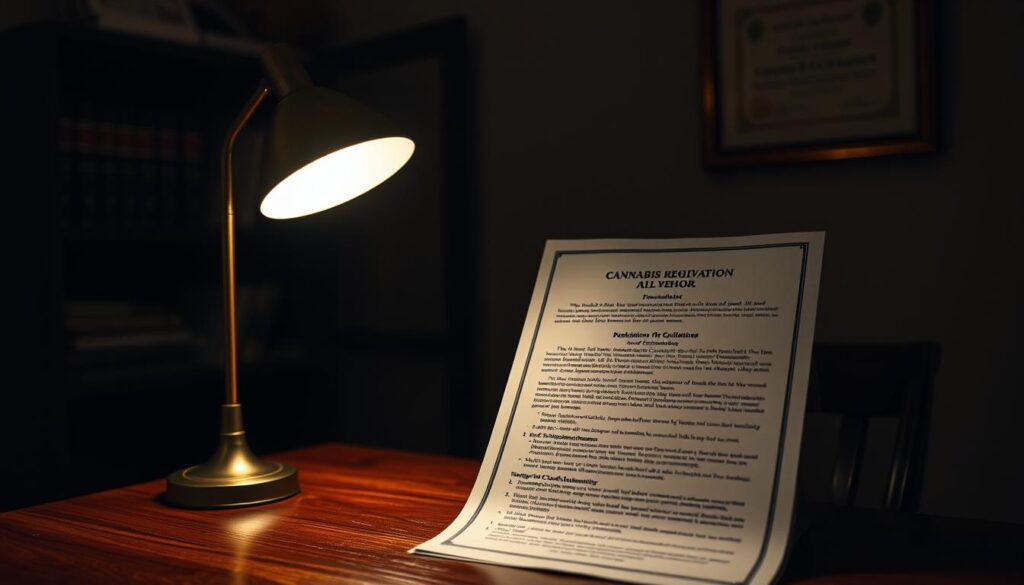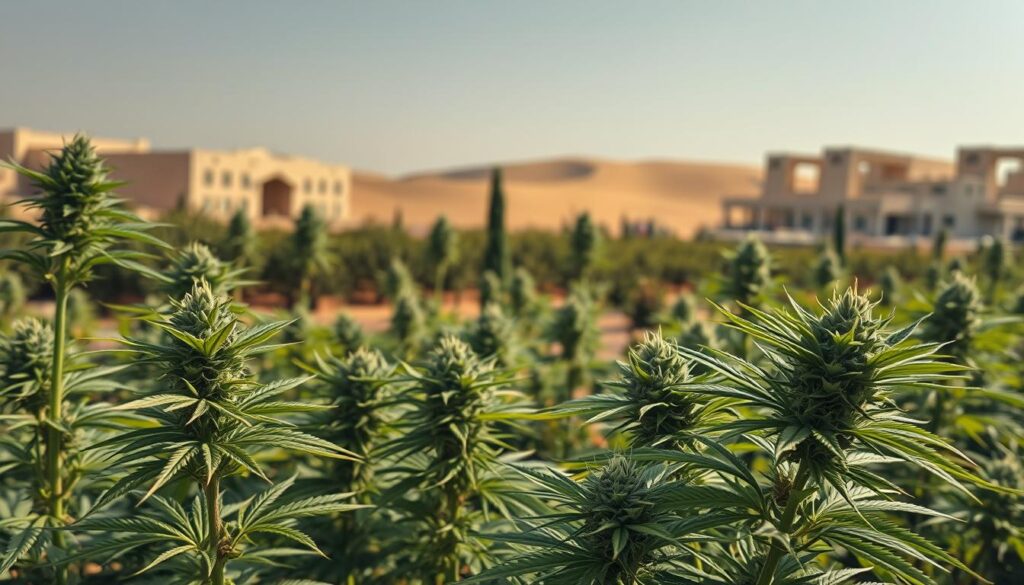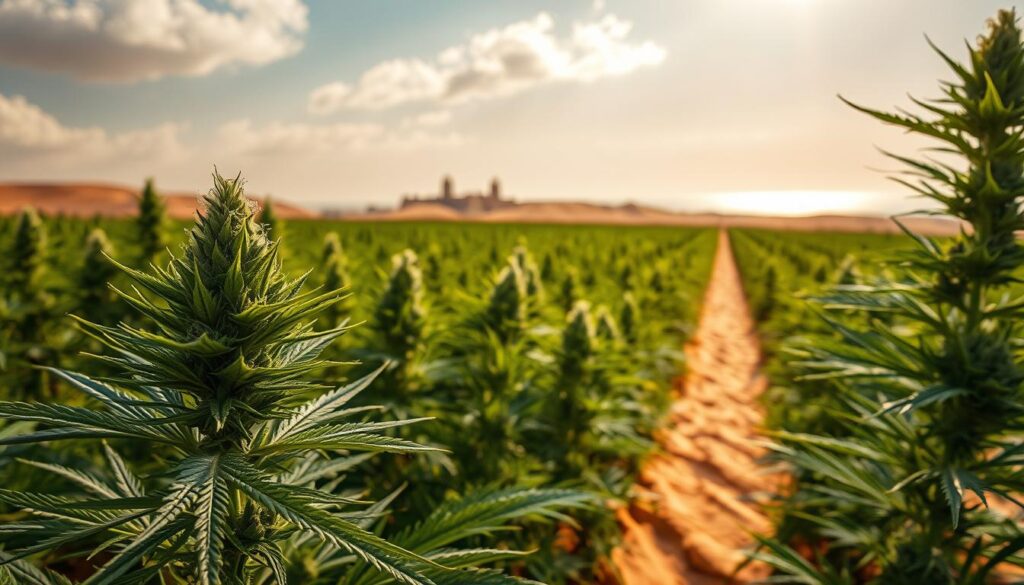Thinking about growing plants in Al Khor’s unique climate? It’s great for those interested in sustainable crops or local farming. The hot, dry weather here is both a challenge and an opportunity, mainly for cannabis sativa.
First, know the law. Industrial hemp, with less than 0.3% THC, is different from the kind that gets you high. It’s been used for centuries in things like clothes and building materials. The hemp market is growing fast, expected to reach $9.4 billion by 2025.
Al Khor’s sun and little rain mean you need special plans. Choose plants that don’t need much water and prepare the soil well. Many growers use shade and drip irrigation to keep plants safe from the heat. Even though hemp grows well here, check the laws before you start.
Key Takeaways
- Industrial hemp (under 0.3% THC) has different legal status than recreational cannabis
- Al Khor’s climate demands heat-tolerant plant varieties and water conservation methods
- Hemp offers sustainable uses from textiles to biodegradable plastics
- Global demand makes hemp cultivation a growing economic opportunity
- Always consult updated local laws before planting
Understanding the Climate in Al Khor
Growing the best weed in Al Khor needs knowing its tough climate. This coastal city faces very hot summers, with temps around 33°C (91°F). It also gets little rain. You must plan carefully, whether growing inside or outside.
Key Weather Factors for Growth
Cannabis likes temperatures between 16–27°C (60–80°F). But Al Khor’s summers are hotter. This heat can hurt plants, making them wilt or grow slowly.
You might need fans or AC units for indoor grows. Outdoor growers should use shade cloths.
Summer humidity is 60–80%, which can cause mold. Use dehumidifiers indoors and make sure air flows well between plants. Drip irrigation is best for saving water and preventing root rot in Al Khor’s dry weather. Hemp is good for outdoor growing because it can handle drought well.
Seasonal Variations to Consider
Winter is cooler (18–25°C), perfect for growing outside. This is when hemp grows fast, in just 4–5 weeks. But summer gets very hot, over 40°C.
Indoor grows control the climate all year, but cost more in summer. Outdoor growers should pick fast-growing strains. Watch weather apps for sandstorms that can harm plants. A simple greenhouse with good ventilation helps with the changing seasons.
Legal Considerations for Growing Weed
Before you start growing plants in Al Khor, you must know the laws. Qatar has very strict rules about cannabis. There’s no room for personal use or small growing.

Current Laws and Regulations
Qatar sees cannabis as a controlled substance. Industrial hemp is the only okay exception. Here’s what you need to remember:
- All cannabis plants must test below 0.3% THC – even trace amounts above this limit are illegal
- Only government-approved CBD-focused hemp cultivation is permitted
- Importing seeds without proper documentation risks immediate confiscation
| Legal CBD Hemp | Illegal Marijuana |
|---|---|
| THC ≤0.3% | THC >0.3% |
| Requires state permits | No legal cultivation |
| Medical/research use only | Recreational prohibition |
Consequences of Non-compliance
Having unauthorized plants can lead to big problems. First-time offenders might face:
- Fines up to QAR 50,000 ($13,700)
- Minimum 6-month imprisonment
- Deportation for non-citizens
Trying to buy weed Al Khor privately is risky too. Police use special kits to check THC levels. Even accidental pollination from nearby plants can get you in trouble.
Choosing the Right Strain for Your Environment
Finding the best cannabis strain for Al Khor’s climate is key. It’s not just about what you like. It’s about keeping your plants healthy. We’ll look at the best strains for the area and what you need to think about.
Popular Strains for Local Conditions
Al Khor’s weather is tough. But some strains can handle it well. Here are some top picks:
- Charlotte’s Web: A CBD-rich strain good for health, with little THC.
- Fedora 17: It grows fast and doesn’t need much water, perfect for outdoors.
- Northern Lights Auto: It grows quickly and avoids the summer heat.
- Amnesia Haze: It fights off pests and mold well, even in humid weather.

Factors to Consider When Selecting Strains
Choosing the right strain affects your harvest and legal status. Remember these important points:
- Growth Cycle: Auto-flowering strains save time and avoid bad weather.
- Climate Adaptability: Look for strains that can handle drought or high heat.
- THC Compliance: Buy seeds from trusted places in the EU or Canada to meet THC limits.
- Pest Resistance: Choose hybrids that fight off pests naturally, cutting down on pesticides.
Pro tip: Always check seed bank reviews. Good places like Royal Queen Seeds or Crop King Seeds offer tested seeds for tough climates.
Setting Up Your Growing Space in Al Khor
Success in growing weed in Al Khor starts with a good growing space. You can use a spare room or a backyard. Planning well helps your plants grow well in Qatar’s climate. Let’s look at your options and tools for a great setup.
Indoor vs. Outdoor Growing Options
Indoor growing lets you control light, temperature, and humidity. This is great in Al Khor’s hot summers. You’ll need good LED lights and HVAC systems. But, these can cost a lot, over $500 for a basic setup.
Outdoor growing uses natural sunlight. You’ll need shade cloths and fast-draining soil. Remember, plants need space. For seeds, use 15–25 plants per square meter. For fiber, you can have 40–80 plants in the same area.
| Factor | Indoor | Outdoor |
|---|---|---|
| Startup Cost | $500+ | $100-$300 |
| Climate Control | Full | Partial |
| Plant Density | Adjustable | Fixed by space |
Essential Equipment for Success
These tools are must-haves:
- pH meters – Test soil acidity weekly
- Grow tents – Keep 60-70% humidity for seedlings
- Organic fertilizers – Fish emulsion and bone meal are great
Finding supplies locally can be hard. Many use weed shop Al Khor services for Al Khor weed delivery. Always check seller reputations before buying online.
Creating an Optimal Environment
Keep plants at 75-85°F during the day. At night, don’t let it get below 65°F. Use heating mats if it’s cold outside.
Good airflow stops mold. Use fans indoors or choose breezy spots outside.
For humidity:
- Seedlings: 65-70% RH
- Vegetative stage: 40-60% RH
- Flowering: 30-50% RH
Check humidity daily with digital hygrometers. Small changes can make a big difference in your plants!
Nutrients and Soil for Your Weed Plants
Growing strong, healthy cannabis in Al Khor starts with two basics: the right soil and balanced nutrition. The region’s dry climate is a challenge. But, choosing the right soil and managing nutrients can make your garden thrive.
Best Soil Types for Healthy Growth
Al Khor’s soil is sandy and drains fast but lacks nutrients. For cannabis, sandy loam is best. It holds moisture and lets roots breathe. Add compost to increase organic matter and perlite for better drainage.
Understanding Nutrient Requirements
Cannabis needs nitrogen (N), phosphorus (P), and potassium (K). During growth, use an NPK ratio of 3:1:2. Calcium and magnesium are also key, as Al Khor’s water often lacks them. Organic options like bone meal release nutrients slowly. Synthetic fertilizers offer precision. Choose what fits your growing style.
Tips for Feeding Your Plants
Don’t overwater. Let the soil dry a bit before watering again. Start with half-strength doses and increase slowly. Check pH levels often—6.0 to 6.5 is best for absorption. For tips on growing in local conditions, look at region-specific guides.
Remember, less is more. Yellow leaves mean you might be overfeeding. Brown tips could be salt buildup. Adjust as needed, and your plants will grow well.
Maintenance Tips for Healthy Weed Plants
To keep your cannabis plants healthy in Al Khor, you need to care for them every day. We will talk about watering and keeping pests away. With the right steps, your plants will grow strong and healthy.
Watering Guidelines for Optimal Growth
When you water your plants, timing and method are key. Drip irrigation systems save water and keep the soil moist. Water in the early morning or late evening to cut down on evaporation.
| Method | Frequency | Key Benefit |
|---|---|---|
| Drip Irrigation | Every 2-3 days | Prevents root rot |
| Soaker Hoses | 3x weekly | Even soil saturation |
| Hand Watering | As needed | Flexible adjustments |
To check if your soil needs water, stick your finger into it. If it’s dry, it’s time to water. Remember, too much water is worse than too little in Qatar’s humid climate!
Pest and Disease Management Strategies
Spider mites and aphids love cannabis as much as you do. Neem oil is a great way to start fighting pests. Mix 2 tablespoons of neem oil per gallon and spray your plants every week. For really bad infestations:
- Release ladybugs to eat soft-bodied pests
- Apply diatomaceous earth around plant bases
- Trim affected leaves immediately
Local hydroponic stores and weed dispensaries in Al Khor have organic pest solutions. Change your pest control methods often to keep pests from getting used to them.
“Hemp’s natural phytoremediation properties help cleanse soil of toxins, creating a healthier environment for subsequent grows.“
Harvesting and Curing Your Weed
Knowing when to harvest is key for the best weed Al Khor can offer. Look for amber pistils curling in and buds that feel sticky. Trichomes should mostly look milky, with 70% opacity for the best potency.
Signs Your Plants Are Ready to Harvest
Check fan leaves every day as the plants stop growing. Yellowing leaves and dense buds mean it’s time. Don’t wait for all trichomes to turn amber, as it can lower THC levels.
Use jeweler’s loupes or pocket microscopes for a close look.
Effective Curing Techniques for Quality Buds
Hang whole branches upside-down in dark rooms with 60% humidity for 7-10 days. When stems snap, move buds to airtight glass jars. Open jars twice a day for 14 days to let moisture out.
This slow curing keeps terpenes better than other methods. Store buds in cool, dark places to keep quality up. Use the right nutrients and climate control for the best results all year.

